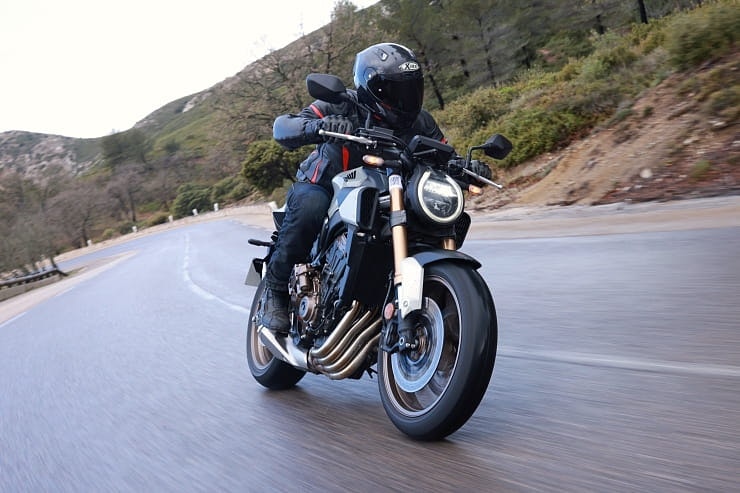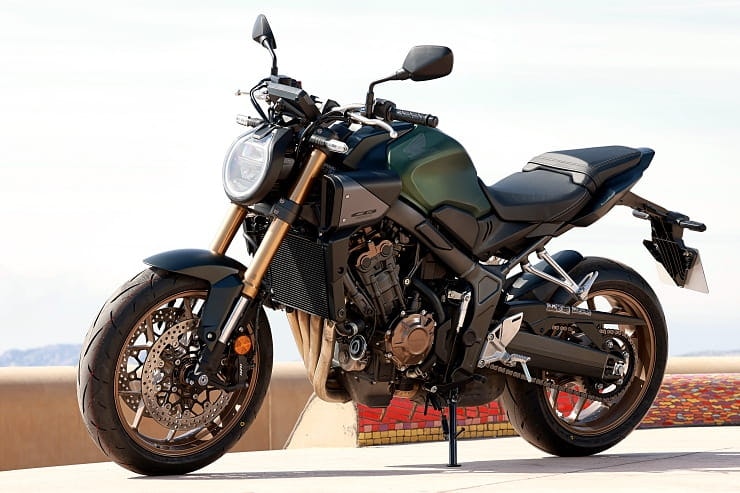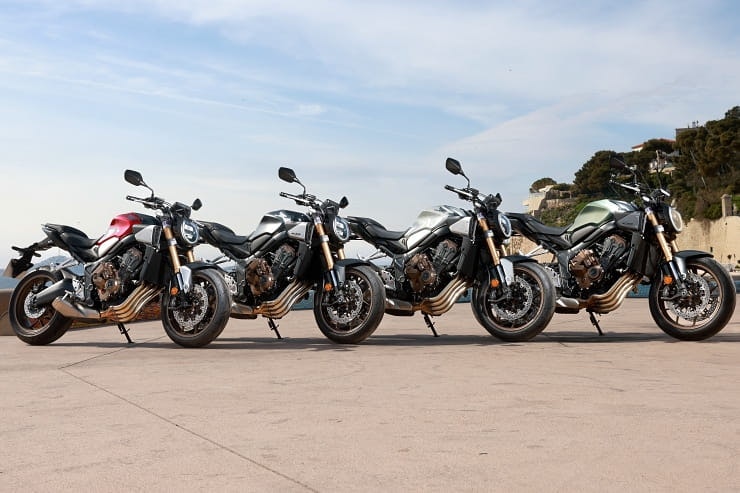Technical review: Ben Purvis
Press launch review: Martin Fitz-Gibbons
£7799 - £7899
94bhp
205kg - 207kg
4/5
Five years ago Honda’s cuddly CB650F caterpillar crawled into a chrysalis and emerged as the smart, streetwise, stylish “Neo Sports Café” CB650R. Ever since it’s been a huge hit across Europe – always one of the continent’s two biggest-selling nakeds, always one of Honda’s top three sellers, and more than 40,000 bikes sold. But then last year things changed: Honda’s beautiful butterfly got gobbled up by a Hornet.
Joining Honda’s naked-middleweight lineup, the twin-cylinder CB750 newcomer proved lighter, punchier and an awful lot cheaper than the CB650R. Instantly the Hornet became Honda’s outright best-seller, cannibalising sales of the 650 and knocking it off Honda’s podium for the first time ever.
Still, Honda clearly believe there’s room for both machines in their range, as for 2024 they’ve updated the CB650R with a fresh look, a light dusting of new bits and, most curiously of all, an optional new system called E-Clutch. An innovative blend of manual gearbox and automatic clutch, it’s a completely different setup to Honda’s love-it-or-hate-it DCT. So, does E-Clutch successfully bridge the gap between auto and manual worlds, and is there still room for the CB650R in Honda’s lineup?
Subtle styling overhaul has sharpened up its lines
E-Clutch option is unique in the class and handy in traffic
New TFT clocks are clearer and classier than the old LCD dash
Inline four engine lacks bottom-end grunt next to rivals
Honda’s own CB750 Hornet is at least £500 cheaper
Lack of blipper means E-Clutch downshifts could be smoother
2024 Honda CBR650R & CB650R Review
A nose-to-tail subtle restyle, a touch more tech, and the all-new E-Clutch system arrives on the 2024 CBR650R and CB650R, so Mufga goes to ride them both.
2024 Honda CB650R Price
The 2024 Honda CB650R E-Clutch costs £7899 on the road. That’s just £100 more expensive than the manual-clutch version, at £7799. And that, in turn, is only £100 more than a CB650R cost in 2023 – though, curiously, the old bike is still listed on Honda UK’s website, now with its price dropped to £7199 presumably to help clear stock.
The price is identical for all four colours that the new CB650R is available in: red; black; grey; and dark green. If you’re thinking of buying one on PCP, it’s available for just £99 a month under Honda’s own official finance scheme. You’ll need a deposit of £1658.81, then three years of monthly £99 payments, followed by an optional final payment of £4212.27 to keep the bike at the end. That works out to an APR of 9.9%, and assumes you’ll ride 4000 miles per year.
If PCP isn’t for you and you’d rather go down the traditional HP finance route, you’ll need a deposit of £2301.73, then 36 monthly payments of £179.00. APR is unchanged at 9.9%.
(Finance quotes accurate in March 2024)
2024 Honda CB650R Engine & Performance
The CB650R’s engine is ultra-familiar: a 649cc inline four with a lineage that can be effortlessly traced back a full decade to the debut of the 2014 CB650F. For ’24 Honda’s engineers have made a microscopic change to intake valve timing (see the graph in the picture carousel above), which has fractionally raised the torque curve at low revs. Peak figures are unchanged, with 46lb·ft tucked away up at a lofty 9500rpm, and maximum power remaining an A2-restrictable 94bhp way up at 12,000rpm.
Although Honda have now made the motor Euro 5+ compliant (the current emissions standard), the throttle is still solely cable-operated. There’s no ride-by-wire, nor a set of computer-controlled secondary butterflies. As such there aren’t any selectable riding modes, though there is traction control which can be turned off at the (long) push of a button.
How does the engine feel? Exactly like it has done for years. By middleweight inline four standards it’s a pretty grunty design, but next to the latest generation of twins and triples that have swarmed into the class (Suzuki GSX-8S, Triumph Trident, KTM 790 Duke, etc) it’s noticeably unhurried and chillaxed low down. Over the first two-thirds of the rev range it’s serene, linear and well-mannered, or at least it is once you’ve got past a slight abruptness to the fuelling on the very initial throttle opening. Performance-wise, however, it only really gets into its groove from 8000rpm. Loads of fun if you enjoy the challenge of keeping a motor on the boil, for sure, but it’s an engine character that seems at odds with the CB’s upright, relaxed ergonomics. Great to still have the choice of an inline four in this class but, truth be told, the revvy power delivery feels a better fit for its fully-faired sibling, the CBR650R.
And then we get to the definitely-not-the-same-as-it’s-always-been bit: E-Clutch. This is Honda’s brand new – and, it should be stressed, completely optional – concept for a part-auto, part-manual transmission. The short version is that the clutch is electronically opened and closed by a pair of small electric motors, so you don’t need to do anything. It’ll feed the clutch out as you pull away, disengage it when you come to a stop, and when you change gear it works the clutch by itself. What E-Clutch doesn’t do, unlike DCT, is change gear for you. The gearbox itself is still 100% manual, with a regular gear lever down by your left foot. The result is something along the lines of a two-way quickshifter, without the need to pull the clutch in when you stop. But there’s a bit more to it than that, for two reasons.
Firstly, because E-Clutch isn’t an alternative to a quickshifter – it incorporates one. There’s a load sensor on the shift rod and, just like a quickshifter, when you prod the pedal the ECU alters fuel injection and ignition timing to briefly interrupt drive and allow the next gear to slot in. E-Clutch does all of that, but it also opens the clutch momentarily to make for a smoother, faster shift. Honda say E-Clutch is 20% faster than a quickshifter alone.
Secondly, even though E-Clutch is capable of operating the clutch autonomously, Honda have also gone to the trouble of fitting a regular clutch lever. If you choose to use it, it’ll always cancel and override whatever E-Clutch is doing. In practice, this is most useful at ultra-slow (say, 10mph or less) speeds – say, filtering through dense city traffic, or the middle of a rushed U-turn – where precise, predictable clutch control is crucial.
Does E-Clutch work? Most of the time, yes. Around town it’s definitely a handy addition to have, especially if your daily commute involves an endless run of red lights, and having the ability to instantly switch over to manual clutch control really does mean you’re never losing out on ultimate control. On upshifts, E-Clutch is every bit as good as a good quickshifter, and better than plenty. It works smoothly and slickly at high or low revs, at small or wide-open throttle openings, and even in the tricky first-to-second change through neutral where some quickshifters struggle.
E-Clutch’s limitations are noticed in two areas. First, when you’re driving away from a standstill E-Clutch seems keen to get the clutch engaged really quickly – definitely keener than my left hand naturally is. As a result, the system can occasionally feel a touch rushed and urgent, perhaps amplified by that abrupt throttle response. And second, in downshifts, which aren’t as seamlessly smooth as a really good two-way quickshifter. This, however, is more than likely not a fault of E-Clutch, but more specifically this 650 engine’s lack of ride-by-wire, which means it’s unable to blip the throttle to rev-match. Combine E-Clutch with a ride-by-wire throttle and you’d surely have the slickest-shifting manual gearbox around.
2024 Honda CB650R Handling & Suspension (inc. Weight & Brakes)
The CB’s chassis is 99% the same as the previous model. It retains its steel ‘diamond’ (twin-spar) frame, 41mm Showa Separate Function Forks, and preload-adjustable monoshock out back. Steering geometry is no different, standard-issue wheel and tyre sizes are unchanged, and brakes remain four-piston radially mounted Nissin calipers up front with an unswitchable ABS system.
Technical differences are tiny. The rear subframe has been slightly trimmed down, saving a claimed 424g of metal. Forks have a slightly softer spring and firmer compression damping, said to improve the ride quality. And the standard tyres are now Dunlop Roadsport 2s with a new compound and tread pattern.
Kerb weight is up a couple of kilos, which can only be a result of either the new styling, or the extra gubbins needed to meet Euro 5+. The manual-clutch CB650R is now 205kg, while the E-Clutch version is just 2kg heavier at 207kg. Given that DCT typically adds around 10kg to the weight of a bike, it’s clear just how much lighter and simpler E-Clutch is.
On the road, the CB650R – unsurprisingly – handles just like it did before, with that absolutely classic Honda combination of predictability, linearity and neutrality. It’s phenomenally well-balanced at low speed, is more than happy to be chucked around with the leverage from the wide handlebar once you get going, and never once threatens the slightest hint of instability. It goes exactly where you expect, holds a line nicely, gives decent feedback, and the budget suspension gives an impression of quality above its price point. Brakes give a good blend of power and feel without any grabbiness, the ABS never steps in where it’s not welcome. All in all, lovely stuff.
2024 Honda CB650R Comfort & Economy
Again, there are basically zero changes from the previous CB650R. Ergonomics are identical, with the exact same handlebar, seat and peg position. The tail unit of the bike has been restyled – as has the headlight, the air intakes, and practically every plastic panel on the bike – but seat height remains unchanged at an accessible 810mm.
The resulting riding position remains easygoing and welcoming – neither too sporty nor too upright, with enough sense of scale and substance for a full-size grown-up rider to feel comfortably accommodated, but not so much room that it’d daunt a smaller, less experienced or less confident novice. Basically, if you don’t fit a CB650R, chances are it’s not the bike’s fault…
The fuel tank holds the same 15.4 litres as before, and claimed fuel economy remains an identical 57.6mpg. Reserve capacity is 3 litres, so expect 150-160 miles to the fuel light, and a maximum theoretical range of 195 miles between brimmed and empty.
2024 Honda CB650R Equipment
Leaving aside E-Clutch, the single biggest improvement to the 2024 CB650R is its new 5-inch colour TFT dash. Large, clear, intuitive and far more modern-looking than the black-on-white LCD clocks on the previous bike, there’s even a choice of three different layouts. There’s also now Bluetooth smartphone connectivity using Honda’s RoadSync app, which lets a rider control music and calls, or use turn-by-turn navigation.
Driving all this is new left-hand switchgear, with a four-way toggle, and indicators still found in a surprising-at-first location beneath the horn. One neat touch is that this cluster is now backlit, making it easier to find at night.
As far as official extras and accessories go, there’s plenty. Honda have even handily bundled together three ‘packs’. There’s a Comfort Pack (£450: heated grips, tankbag, tailpack), a Sport Pack (£620: bellypan cowl, seat cowl, flyscreen, tank pag, quickshifter for non-E-Clutch bikes) and a Style Pack (£525: aluminium inserts for the air intakes, mudguard and side panels, plus an anodised oil level gauge).
2024 Honda CB650R Rivals
The CB650R probably faces tougher competition than ever before, thanks to a wealth of middleweight-naked choice in recent years. For our money the closest competitor on style and performance has to be Triumph’s hugely popular Trident 660. We’d also put KTM’s 790 Duke in there, as it won our most recent four-bike middleweight naked group test. And last but not least, probably the most direct competition comes from within a Honda dealership, in the form of the CB750 Hornet – more engine, more torque and less weight for less money. You could also add Suzuki’s GSX-8S, Aprilia’s Tuono 660, BMW’s F900R and plenty more besides to the mix, but despite all the choice, one thing lacking from its list of rivals is another four-cylinder engine.
Triumph Trident 660 | Price: £7895
80bhp / 47lb-ft
189kg
KTM 790 Duke | Price: £7999
94hp / 64lb-ft
187kg
Honda CB750 Hornet | Price: £7299
91bhp / 55lb-ft
190kg
2024 Honda CB650R E-Clutch Verdict
The verdict really divides up into two parts: is E-Clutch worth having; and does the CB650R still offer something over the immensely popular Hornet 750?
Let’s start with the easy one first. Yes, E-Clutch is absolutely worth having. It’s just £100 more than the standard model, and offers more features and functionality than a one-way quickshifter costing £278 fitted. For little more than a third of the price, you get faster and smoother upshifts, plus the ability to downshift without using the clutch lever. That alone makes it worth opting for – regardless of whether you like not having to pull the clutch in at a standstill. But if you do a lot of town riding, it’s a definite plus on top of all that.
Is E-Clutch absolutely perfect and utterly beyond any nit-picking criticism in every single riding scenario? No. Nor was it likely to be for a first iteration. It’s clear there’s room for improvement – most obviously the addition of a ride-by-wire throttle which could smooth out standing-start pickup as well as more sweetly rev-matched downshifts. Perhaps that’ll come on a future update. But even as it stands, it’s an impressive and genuinely useful debut for the technology.
Is there still room in Honda’s range for a CB650R and a CB750? Yes – just about. The 650R is very different to its more popular parallel twin stablemate. Physically the 650 feels more solid, more substantial, with a classier air. Overall, it makes the Hornet feel smaller, a little more flimsy, a little more toy-like. A newer rider would likely find the Hornet’s manageable size confidence-inspiring, but a veteran rider will likely prefer the CB650R’s more grown-up feel, both in its physical proportions as well as its on-road dynamic.
All in all then: is E-Clutch such an astonishingly game-changing system that it’d tempt us away from a rival bike to pick a CB650R instead? Probably not. But for riders who are already convinced by the CB650R’s unique mix of sporty heart, comfortable stance, classy feel and stylish image, the E-Clutch system is absolutely worth having. For the relatively trivial cost of £100 and 2kg, it’s virtually a no-brainer.
If you’d like to chat about this article or anything else biking related, join us and thousands of other riders at the Bennetts BikeSocial Facebook page.
2024 Honda CB650R Technical Specification
Looking for motorcycle insurance? Get a quote for this motorbike with Bennetts bike insurance
What is MCIA Secured?
MCIA Secured gives bike buyers the chance to see just how much work a manufacturer has put into making their new investment as resistant to theft as possible.
As we all know, the more security you use, the less chance there is of your bike being stolen. In fact, based on research by Bennetts, using a disc lock makes your machine three times less likely to be stolen, while heavy duty kit can make it less likely to be stolen than a car. For reviews of the best security products, click here.
MCIA Secured gives motorcycles a rating out of five stars (three stars for bikes of 125cc or less), based on the following being fitted to a new bike as standard:
A steering lock that meets the UNECE 62 standard
An ignition immobiliser system
A vehicle marking system
An alarm system
A vehicle tracking system with subscription
The higher the star rating, the better the security, so always ask your dealer what rating your bike has and compare it to other machines on your shortlist.


